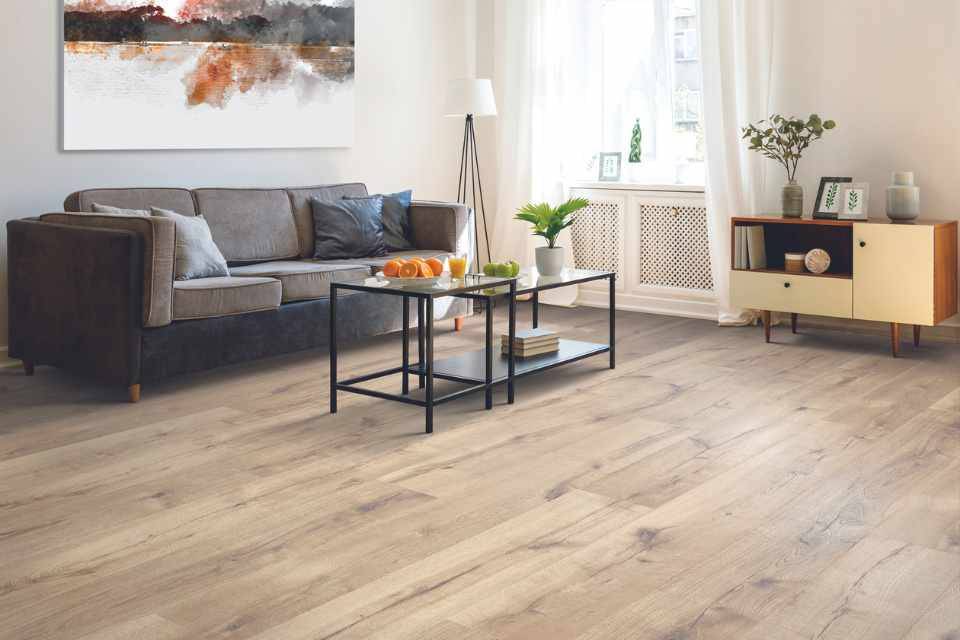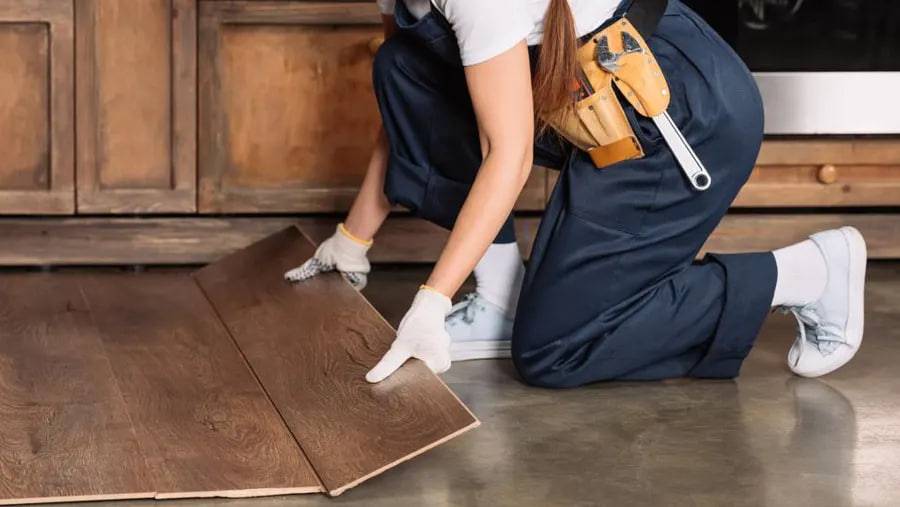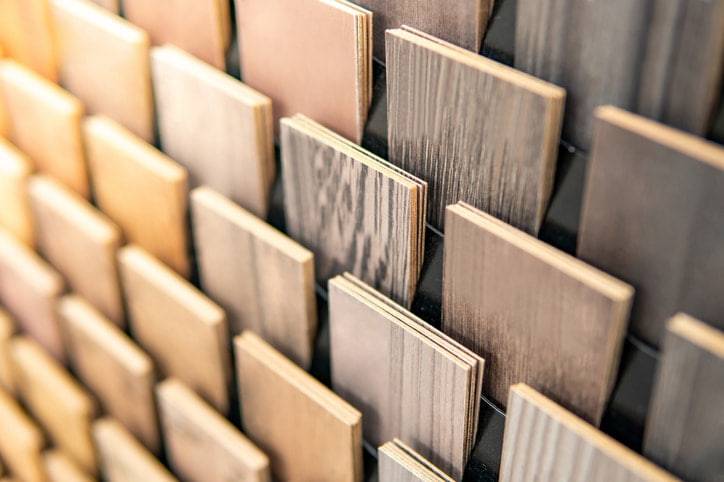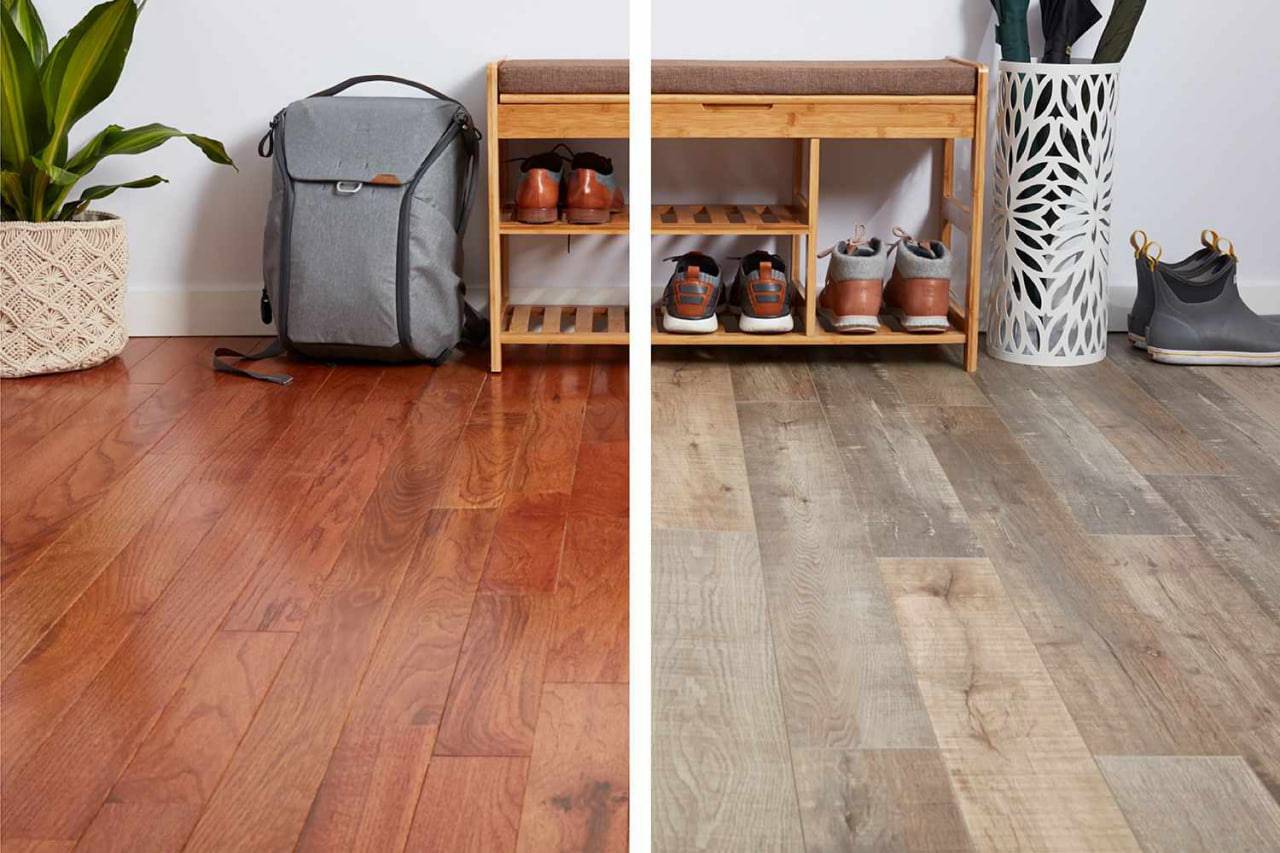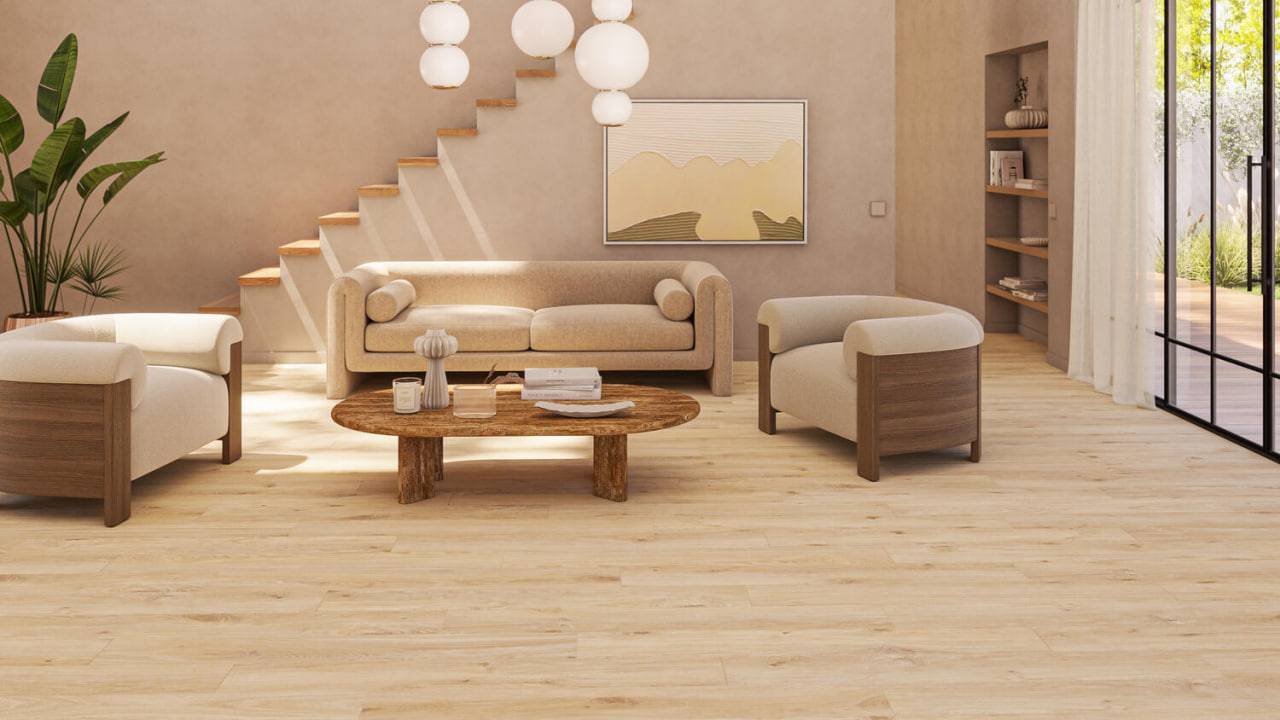Laminate flooring is a popular choice for homes thanks to its combination of affordability, durability, and ease of installation. However, some people may be concerned about its cooler feel underfoot compared to hardwood.
What is laminate flooring?
Imagine a multi-layered cake. Laminate flooring is similar, with four distinct layers:
-
- Top wear layer: A clear, protective layer that resists scratches, stains, and fading.
- Decorative layer: A high-resolution image that replicates the look of wood, stone, tile, or even concrete.
- Core layer: A high-density fiberboard that provides stability and strength.
- Backing layer: A moisture-resistant layer that protects against warping and mildew.
Pros and Cons of Laminate Flooring:
Pros:
- Affordable: Compared to real wood or tile, laminate flooring is a budget-friendly option.
- Durable: The wear layer protects against scratches, stains, and fading, making it ideal for high-traffic areas.
- Easy to install: Many laminate flooring products feature a click-lock system for easy DIY installation.
- Low maintenance: Regular sweeping and mopping are all you need to keep laminate flooring looking its best.
- Versatile: Laminate flooring comes in a wide variety of colors, patterns, and textures. For instance, you can find laminate that mimics the look of natural wood, stone, or even concrete..
- Moisture resistant: While not waterproof, laminate flooring can handle spills and occasional splashes.
Cons:
- Cooler and harder underfoot than real wood or carpet.
- Hollow sound when walked on.
- Can be slippery when wet.
- Not as repairable as other flooring options.
- May not be suitable for heavy furniture or pets with sharp claws.
What Are the Different Types of Laminate Flooring?
When it comes to laminate flooring, you have options! Firstly let’s explore the different types to find the perfect fit for your home:
Types by Material:
- Firstly High-pressure laminate (HPL): The most common and durable type, perfect for high-traffic areas.
- Secondly Melamine laminate: A more budget-friendly option, but less scratch-resistant than HPL.
- Lastly Compact laminate: Super tough and waterproof, ideal for commercial spaces.
By Finish:
- Glossy: Reflects light, making spaces feel brighter but showing scratches more easily.
- Matte: Hides imperfections and provides a natural look.
- Textured: Offers grip and a rustic feel, mimicking wood grains or other textures.
- Embossed: Adds depth and dimension to the pattern, enhancing realism.
By Plank Size:
- Standard planks: Around 5-8 inches wide, offering a timeless look.
- Long and narrow planks: Up to 12 inches wide, creating an illusion of spaciousness and a modern feel.
- Wide planks: Over 8 inches wide, adding a dramatic and luxurious touch.
By Edge Profiles:
- Click-lock: Easiest to install, planks simply click together without glue.
- Fold-down: Another DIY-friendly option, planks fold down into place.
- Tongue and groove: Traditional method requiring glue, often used for commercial installations.
Bonus Options:
- Water-resistant laminate: Can handle spills and occasional splashes, but not suitable for wet areas.
- Acoustic laminate: Features a sound-dampening layer for quieter walking.
Laminate Flooring vs Hardwood
In contrast to hardwood, laminate flooring is not as repairable. However, its affordability and ease of installation make it a good option for budget-conscious homeowners. Let’s compare them side-by-side to help you make the best choice for your home:
| Factor | Laminate Flooring | Hardwood Flooring |
| Cost | Affordable | Expensive |
| Durability | Scratch-resistant and water-resistant, but not waterproof. Can’t be refinished. | Very durable, can be refinished multiple times for extended life. |
| Maintenance | Easy to clean, just sweep and mop. | Requires more care, regular polishing and occasional sanding/refinishing. |
| Appearance | Wide variety of colors and patterns, replicates wood, tile, and other materials. | Natural beauty of real wood, warm and classic look. |
| Feel underfoot | Can be cold and hard, less comfortable than hardwood. | Warm and soft underfoot, adds a natural feel. |
| Installation | Easy DIY installation with click-lock systems. | Professional installation recommended due to difficulty and potential for damage. |
| Lifespan | 10-25 years | 50+ years with proper care |
| Environmental impact | Made with recycled materials in some cases. | Renewable resource, but deforestation concerns exist. |
| Resale value | Has little impact on resale value. | Increases resale value of your home. |
Here’s a quick summary:
- Choose laminate if:
- Budget is a concern.
- You need a durable and low-maintenance option.
- You appreciate a wide variety of styles and patterns.
- You’re comfortable with DIY installation.
- Choose hardwood if:
- You value natural beauty and classic elegance.
- You want a floor that will last for decades with proper care.
- You’re willing to invest in higher upfront costs and ongoing maintenance.
- You want to increase the resale value of your home.
Ultimately, the best choice for you depends on your individual priorities and budget. Consider your needs, lifestyle, and aesthetic preferences to make an informed decision.
How Do I Clean Laminate Flooring?
Laminate flooring is easy to clean and maintain. Additionally, it’s water-resistant, making it a good choice for kitchens and bathrooms. For optimal soundproofing, consider acoustic laminate options, which feature a specialized underlayment that absorbs noise more effectively. Here’s a simple guide to keeping it clean:
Regular Cleaning:
- Sweep or vacuum daily: This removes dust, dirt, and debris that could scratch the surface. Use a soft brush attachment on your vacuum to avoid scuffing.
- Mop weekly: Use a damp microfiber mop with a pH-neutral cleaner or diluted dish soap. Avoid soaking the floor, just wring the mop nearly dry.
Spot Cleaning:
- Wipe up spills immediately with a clean, absorbent cloth. Be especially quick with sticky spills like food or beverages.
- For stubborn stains, use a diluted solution of white vinegar or rubbing alcohol for spot cleaning. Test in an inconspicuous area first to ensure it doesn’t discolor the flooring.
Things to Avoid:
- Harsh chemicals, abrasive cleaners, and scouring pads: These can damage the surface and dull the finish.
- Excessive water: Laminate flooring is water-resistant, but not waterproof. Avoid soaking the floor or using a steam mop, as this can cause warping.
- Direct sunlight: Over time, direct sunlight can fade laminate flooring. Use blinds or curtains on exposed windows.
Additional Tips:
- Doormats: Use doormats at entryways to prevent dirt and debris from being tracked onto your floors.
- Furniture pads: Place felt pads or protectors on the bottom of furniture legs to prevent scratches and scuffs.
- Regular maintenance: Check your manufacturer’s recommendations for any specific cleaning needs or maintenance procedures.
What Are the Installation Options for Laminate Flooring?
When it comes to installing laminate flooring, you have options! The right choice for you depends on your skill level, budget, and the complexity of your project. Here’s a breakdown of the most common laminate flooring installation methods:
1. Click-Lock System:
- Difficulty: Beginner-friendly
- Cost: Affordable
- Description: Most DIY laminate flooring features a click-lock system. Planks simply click together without glue, creating a fast and easy installation process.
- Pros: No special tools needed, easy to correct mistakes, perfect for smaller rooms.
- Cons: May not be as strong as other methods, might be susceptible to gaps over time.
2. Fold-Down System:
- Difficulty: Beginner-friendly
- Cost: Affordable
- Description: Similar to click-lock, planks fold down into place instead of clicking. Offers a slightly different installation feel.
- Pros: Easy to use, good for beginners, less prone to gaps compared to click-lock.
- Cons: Not as common as click-lock, might require slightly more force for installation.
3. Tongue and Groove:
- Difficulty: Intermediate to advanced
- Cost: Can be more expensive due to professional installation
- Description: The traditional method, planks interlock with grooves and ridges and require glue for bonding. Often used for commercial spaces.
- Pros: Very strong and durable, less prone to gaps, suitable for uneven subfloors.
- Cons: Requires more skill and experience, more time-consuming, often needs professional help.
4. Floating and Glued Down:
- Difficulty: Depends on method chosen
- Cost: Varies depending on chosen method
- Description: Floating installation allows the floor to expand and contract naturally, while glued down offers extra stability and reduces noise.
- Pros: Floating is easy and DIY-friendly, glued down is more secure and quieter.
- Cons: Floating might be prone to gaps, glued down requires more preparation and can be challenging to repair.
Embrace Affordability and Style: Laminate Flooring for Your Home
Craving a beautiful floor that doesn’t break the bank? Look no further than laminate! This flexible flooring option delivers stunning visuals in a kaleidoscope of styles and textures, from classic wood grains to modern stone patterns. And it’s not just eye-catching. Laminate boasts impressive durability, standing up to scratches, spills, and the daily wear-and-tear of busy homes.
Imagine this:
- Easy on your wallet: Laminate is a budget-friendly alternative to pricier flooring options like hardwood or tile.
- Effortless installation: Click-lock systems make DIY installation a breeze, perfect for weekend warriors and creative minds.
- Low maintenance: Regular sweeps and mops keep your laminate floors looking fresh, leaving you more time for the things you love.
- Versatility reigns: Available in a vast array of colors, patterns, and textures, laminate seamlessly blends with any décor, from rustic charm to modern chic.
- Durable delight: Worry less about scratches and spills. Laminate’s tough surface handles everyday living with ease.
To conclude, laminate flooring is a smart choice for those who want a beautiful, durable, and affordable floor. It’s perfect for busy families, creative minds, and anyone who wants to transform their home without breaking the bank.
FAQs:
Is laminate flooring durable?
Laminate flooring is surprisingly tough! Its wear layer protects against scratches, stains, and fading, making it ideal for high-traffic areas. Just avoid sharp objects and excessive moisture.
Is laminate flooring easy to install?
Many laminate flooring products feature a click-lock system for easy DIY installation. No glue needed! Just snap the planks together. Remember, proper subfloor preparation is key for a smooth installation.
How does laminate compare to hardwood flooring?
Laminate is budget-friendly, easy to install, and water-resistant, while hardwood is warmer underfoot, more durable, and can be refinished for extended life. Ultimately, the choice depends on your needs and priorities.
How do I clean laminate flooring?
Regular sweeping and mopping with a damp microfiber mop and pH-neutral cleaner keeps your laminate floor looking fresh. Avoid harsh chemicals, excessive water, and direct sunlight.
Can I install laminate flooring in wet areas?
While laminate flooring is water-resistant, it’s not waterproof. Avoid installing it in bathrooms, laundry rooms, or areas prone to spills.
Is laminate flooring good for pets?
Laminate flooring can handle paws and claws well, but be mindful of sharp claws that could potentially scratch the surface. Regular trimming helps!
Does laminate flooring look realistic?
Modern laminate flooring comes in a vast array of wood, stone, and tile patterns that mimic the real thing with impressive detail.
Is laminate flooring eco-friendly?
Look for laminate flooring made with recycled materials. Proper maintenance also extends its lifespan, reducing waste.
How long does laminate flooring last?
With proper care, laminate flooring can last 10-25 years in residential settings.
Can I refinish laminate flooring?
Unfortunately, no. Laminate flooring has a wear layer that can’t be refinished. However, its long lifespan might make refinishing unnecessary.

